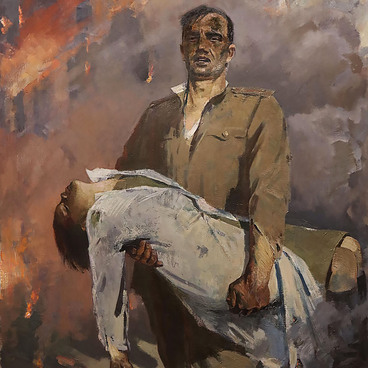Pyotr Buyko was born in Bielsk, Grodno Governorate, on October 31, 1895. He graduated from the Kyiv Medical Institute in 1922 and continued his medical career at the Kyiv Research Institute of Pediatrics, Obstetrics, and Gynecology, which he headed in 1933.
Five years later, Pyotr Buyko defended a thesis and became a Doctor of Medical Sciences. After the beginning of the Great Patriotic War, he volunteered for the front. He served as a surgeon in a medical battalion near the city of Uman.
After being seriously wounded and taken prisoner, Pyotr Buyko ended up in the Fastiv hospital near Kyiv. In February 1942, he joined the hospital staff as a doctor. In this position, he was able to organize an underground resistance movement. In 1942 and 1943, Pyotr Buyko saved many young people and able-bodied collective farm workers from being sent to forced labor in Germany.
Pyotr Buyko managed to establish contacts with Soviet partisans and administer medical aid to them. In June 1943, he fell under suspicion of the Gestapo, the official secret police of Nazi Germany. After that, Pyotr Buyko left his job at the Fastiv hospital and became a doctor for the 4th Partisan Battalion.
On October 13, 1943, the Nazis raided the partisans. Pyotr Buyko was captured between Tomashovka and Yaroshovka villages when he was going from a partisan detachment to Prishivalnya village to deliver medical care to the seriously wounded.
The doctor was brutally tortured. The Nazis beat him, twisted his arms, and suspended him from a beam in a barn. In spite of everything, Professor Pyotr Buyko demonstrated exceptional bravery. He did not reveal the village’s ties with the partisans, their identity, or their location.
On the night of October 14–15, after two days of torture, the battered and disfigured doctor was thrown into the public barn of Tomashovka with his hands bound. There already were 140 arrested peasants.
The prisoners were told that if anyone attempted to escape, everyone would be shot. A particularly harsh punishment was reserved for anyone who provided any assistance to the professor, even by giving him food or water. On October 15, Professor Buyko was doused with two buckets of gasoline, shot, and burned.
Five years later, Pyotr Buyko defended a thesis and became a Doctor of Medical Sciences. After the beginning of the Great Patriotic War, he volunteered for the front. He served as a surgeon in a medical battalion near the city of Uman.
After being seriously wounded and taken prisoner, Pyotr Buyko ended up in the Fastiv hospital near Kyiv. In February 1942, he joined the hospital staff as a doctor. In this position, he was able to organize an underground resistance movement. In 1942 and 1943, Pyotr Buyko saved many young people and able-bodied collective farm workers from being sent to forced labor in Germany.
Pyotr Buyko managed to establish contacts with Soviet partisans and administer medical aid to them. In June 1943, he fell under suspicion of the Gestapo, the official secret police of Nazi Germany. After that, Pyotr Buyko left his job at the Fastiv hospital and became a doctor for the 4th Partisan Battalion.
On October 13, 1943, the Nazis raided the partisans. Pyotr Buyko was captured between Tomashovka and Yaroshovka villages when he was going from a partisan detachment to Prishivalnya village to deliver medical care to the seriously wounded.
The doctor was brutally tortured. The Nazis beat him, twisted his arms, and suspended him from a beam in a barn. In spite of everything, Professor Pyotr Buyko demonstrated exceptional bravery. He did not reveal the village’s ties with the partisans, their identity, or their location.
On the night of October 14–15, after two days of torture, the battered and disfigured doctor was thrown into the public barn of Tomashovka with his hands bound. There already were 140 arrested peasants.
The prisoners were told that if anyone attempted to escape, everyone would be shot. A particularly harsh punishment was reserved for anyone who provided any assistance to the professor, even by giving him food or water. On October 15, Professor Buyko was doused with two buckets of gasoline, shot, and burned.


